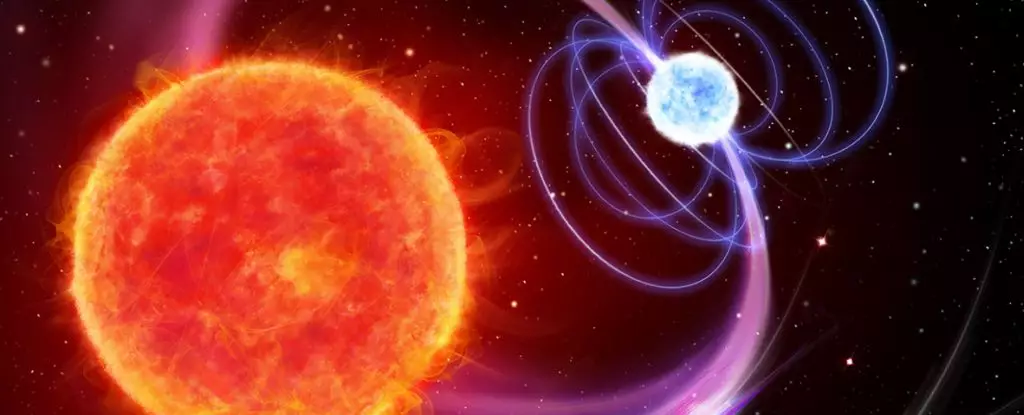In the vast expanse of the Milky Way, an intriguing phenomenon has captured the attention of astronomers: a consistent series of radio wave pulses originating from a previously uncharted binary star system. Spearheaded by Iris de Ruiter at the University of Sydney, the team has pinpointed the source, unearthing a pair of closely orbiting stars that defy traditional classifications. Named ILT J110160.52+552119.62 (or ILT J1101+5521), this discovery not only enriches our knowledge of cosmic phenomena but also challenges established theories regarding radio waves in the universe.
The fascination surrounding ILT J1101+5521 lies in its unique properties. Unlike fast radio bursts, which have captivated astronomers for years with their fleeting yet intense emissions, the signals from ILT J1101+5521 resemble a rhythmic pulse, arriving every 125.5 minutes. This regularity is perplexing; it dictates that the mechanisms responsible for these radio waves may harbor secrets long overlooked in astrophysics.
De Ruiter’s initial detection of the signals came via the LOFAR radio telescope, revealing data dating back to 2015. The signals initially bore similarities to fast radio bursts, powerful emissions believed to stem from cataclysmic celestial events such as magnetar eruptions. However, critical distinctions arose: while fast radio bursts emit energy in milliseconds at staggering distances, ILT J1101+5521’s signals unfolded over minutes and emitted far lower energy levels.
To further understand the source, De Ruiter and her colleagues employed equipment like the Multiple Mirror Telescope in Arizona and the McDonald Observatory in Texas. Through rigorous observation, they confirmed the existence of two intertwined stars: a dim red dwarf and a white dwarf, the remnants of a sun-like star. The proximity of these celestial bodies—where their magnetic fields collide with each revolution—creates conditions ripe for producing radio waves detectable across vast cosmic distances.
The Personal Touch: Collaborative Efforts in Astronomy
One of the most compelling aspects of this discovery is the collaborative spirit that fueled the investigation. De Ruiter emphasizes the collective contributions from diverse fields of astrophysics, enhancing the analysis with various methodologies. Each observation and theory-building exercise brought them one step closer to unraveling the enigma of ILT J1101+5521. This teamwork epitomizes the essence of modern science, illustrating that breakthroughs often arise not from solitary genius but through synergistic collaboration.
The interaction of the two stars—the red dwarf practically dancing around its more subtle white counterpart—reveals an extraordinary gravitational relationship that produces evidence of unpredictability in binary star systems. Such findings urge the astronomical community to rethink existing models that categorize star interactions, particularly those involving magnetars or neutron stars.
Potential Implications for Astrophysics
What makes ILT J1101+5521 pivotal is its potential implications for our comprehension of the universe’s most enigmatic antennas—radio wave sources. While this discovery does not confirm a direct link to fast radio bursts, it does imply that some of these brief, high-energy emissions might have analogous origins, driven by binary star dynamics. The assertion that increased energy levels could correlate with massive star pairings underlines the necessity for expanded research in this area.
Scientists now hold an intriguing question at the forefront: could the intricate dance of a red dwarf and a white dwarf provide insights into other cosmic signals? The study of ILT J1101+5521 invites speculation on the mechanisms behind recurring fast radio bursts, suggesting a new pathway to understanding their varied origins.
Uncharted Territories: Future Studies Await
De Ruiter and her team are committed to further exploring ILT J1101+5521, focusing on probing the characteristics of both the red dwarf and its elusive companion. This investigation will undoubtedly yield a broader perspective on stellar evolution, and the behaviors of binary systems, igniting discussions about cosmic relationships that challenge our comprehension of stellar physics.
Ultimately, the pulse of ILT J1101+5521 serves as a catalyst for re-examining the myriad of signals traversing the cosmos. Such discoveries are more than just markers in a starry sky; they are invitations to dive deeper into the fabric of our universe. The cosmic ballet of two distant stars has opened doors to realms that may redefine our understanding of what exists beyond our planet, urging astronomers to continue their quest for knowledge amidst the stars.


Leave a Reply